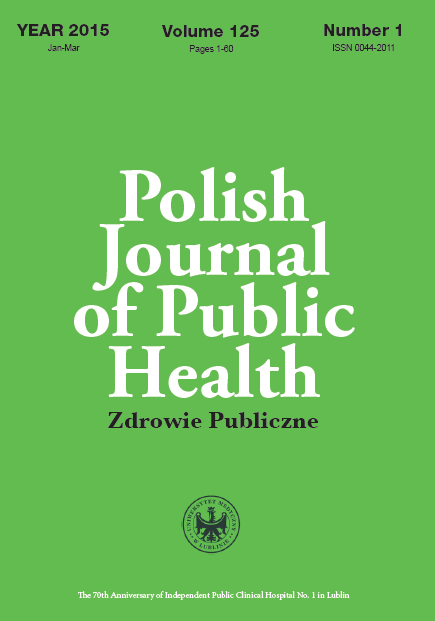Prevalence of self-injury, suicidal ideation, plans and attempts in adolescents aged 13 to 19 years of age
DOI:
https://doi.org/10.1515/pjph-2015-0025Keywords:
suicide, self-injury, adolescentsAbstract
Introduction. Increased suicide rates, both among adults and adolescents, have been seen in Poland over recent years.
Aim. The aim of the study was to determine the prevalence of self-injury, suicide ideation, plans and attempts in adolescents aged 13 to 19 years.
Material and methods. The study encompassed the total number of 6883 individuals aged 13 to 19 years, 69% of them being girls and 31% – boys. All respondents lived in Lubelskie Province. The research was conducted using a questionnaire designed by the authors.
Results. In the group composed of 6883 adolescents living in Lublin Province, suicide ideation was reported by 47.65% of the respondents, suicide plans by 32.35%, suicide attempts were carried out by 10% of adolescents and self-injury by 24.91% of the respondents aged 13 to 19 years.
Conclusions. The greatest prevalence of suicide ideation, plans and attempts, as well as self-injuries, were recorded in the group of adolescents aged 17. The adolescents living in the urban areas are more likely to inflict self-injury than those living in rural areas. Furthermore, adolescents with suicidal tendencies, e.g. attempting suicide and self-injury, are more prone to alcohol and substance abuse. It needs emphasizing that many adolescents with suicidal tendencies, compared against those who did not carry them out, have past experience of psychological, physical and sexual violence in the family, have been raised by a single parent or in families, where one of the parents abused alcohol.
References
1. Hołyst B. Motywacje samobójstw nieletnich. Ministerstwo Sprawiedliwości. Probacja. 2012;3:19-42.
2. Napieralska E. Epidemiologia zgonów dzieci i młodzieży z powodu samobójstw w Polsce w latach 1999-2006. Probl Hig Epidemiol. 2010;91(1):92-8.
3. Gmitrowicz A. Społeczne i psychiatryczne uwarunkowania prób samobójczych u młodzieży. Postępy Psychiatr Neurol. 1999;8:457-64.
4. Komenda Główna Policji. [http://statystyka.policja.pl]
5. Rosa K, Gmitrowicz A. Regionalny Program Zapobiegania Samobójstwom Młodzieży Część I. Charakterystyka populacji regionu łódzkiego. Suicydologia. 2007;3(1):18-22.
6. Rosa K., Merecz D. Międzynarodowy Program Badań nad Zachowaniami Samobójczymi - SUPRE-MISS. Suicydologia. 2005;1:92-7.
7. Gmitrowicz A, Dubla W. Zachowania samobójcze w reprezentatywnej grupie młodzieży z terenu Łodzi. Psychiatr Psychol Klin Dzieci Młodz. 2001;3:236-43.
8. Główny Urząd Statystyczny. Zdrowie dzieci i młodzieży w Polsce w 2009 r. Kraków; 2011.
9. Żechowski C, Namysłowska I. Kulturowe i psychologiczne koncepcje samouszkodzeń. Psych Pol. 2008;42(5):647-57.
10. Klonsky ED. Non-suicidal self-injury in United States adults: prevalence, sociodemographics, topography and functions. Psychol Med. 2011;41(9):1981-6. [PubMed] [CrossRef] [Web of Science]
11. Pawłowska B, Potembska E, Zygo M, et al. Rozpowszechnienie samouszkodzeń dokonywanych przez młodzież w wieku od 16 do 19 roku życia. Psych Pol. 2016;50(1) (in press).
12. Zoroglu SS, Tuzun U, Sar V, et al. Suicide attempt and self-mutilation among Turkish high school students in relation with abuse, neglect and dissociation. Psychiatry Clin. Neurosci. 2003;57(1):119-26. [PubMed] [CrossRef]
13. Lewinsohn PM, Rohde P, Seeley JR, Baldwin CL. Gender differences in suicide attempts from adolescence to young adulthood. J Am Acad Child Adolesc Psychiatry. 2001;40(4):427-34. [CrossRef]
14. Borges G, Walters EE, Kessler RC. Associations of substance use, abuse, and dependence with subsequent suicidal behavior. Am J Epidemiol. 2000;151(8):781-9.
15. Nock MK, Green JG, Hwang I, et al. Prevalence, correlates, and treatment of lifetime suicidal behavior among adolescents: results from the National Comorbidity Survey Replication Adolescent Supplement. JAMA Psychiatry. 2013;70(3):300-10. [PubMed] [Web of Science] [CrossRef]
16. Zakharov S, Navratil T, Pelclova D. Suicide attempts by deliberate selfpoisoning in children and adolescents. Psychiatry Res. 2013;210(1):302-7. [Web of Science] [CrossRef]
17. Wichstrøm L. Predictors of adolescent suicide attempts: a nationally representative longitudinal study of Norwegian adolescent. J Am Acad Child Adolesc Psychiatry. 2000;39(5):603-10. [CrossRef]
18. Kelly TM, Lynch KG, Donovan JE, Clark DB. Alcohol use disorders and risk factor interactions for adolescent suicidal ideation and attempts. Suicide Life Threat Behav. 2001;31(2):181-93. [PubMed] [CrossRef]
19. Wu P, Hoven CW, Liu X, et al. Substance use, suicidal ideation and attempts in children and adolescents. Suicide Life Threat Behav. 2004;34(4):408-20. [PubMed] [CrossRef]
Downloads
Published
Issue
Section
License
Copyright (c) 2015 Polish Journal of Public Health

This work is licensed under a Creative Commons Attribution-NonCommercial-NoDerivatives 3.0 Unported License.


